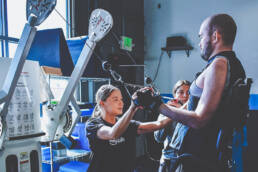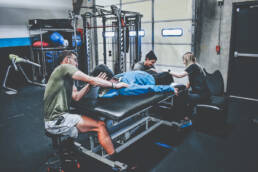Functional Electric Simulation (FES)
Functional electric simulation is a treatment that applies small electrical charges to a muscle that has become paralyzed or weakened. The electrical charges stimulate the muscle to make its usual movement.
This innovative therapy has been shown to provide a number of benefits to individuals with paralysis, improving both their physical and emotional wellbeing.
By stimulating the muscles that are no longer under voluntary control, individuals with paralysis can improve their muscle strength and endurance, which can help them to perform activities of daily living more independently.
Benefits of FES:
- Increased muscle strength and endurance
- Prevents muscle atrophy
- Improved circulation
- Positive impact on emotional wellbeing
Increased Muscle Strength & Endurance:
By stimulating the muscles that are no longer under voluntary control, individuals with paralysis can improve their muscle strength and endurance, which can help them to perform activities of daily living more independently. For example, FES can be used to help someone with a spinal cord injury to stand up from a wheelchair, take steps, or even to ride a bicycle.
Prevents Muscle Atrophy:
Muscle atrophy can cause weakness and other complications, which can make it even more difficult for individuals with paralysis to perform daily activities. By stimulating the muscles, FES can help to prevent muscle wasting and preserve muscle strength.
Improved Circulation:
Individuals with paralysis are at a higher risk for developing circulation problems, such as blood clots and pressure sores, which can be dangerous and even life-threatening. FES can help to improve circulation and reduce the risk of these complications, helping to keep individuals with paralysis healthier and more comfortable.
Impact on Emotional Wellbeing:
Living with paralysis can be a difficult and isolating experience, but by providing greater independence and functionality, FES can help to improve confidence, self-esteem, and overall quality of life.
Take the Next Step Toward Recovery
Whether you’re just beginning your journey or looking for new ways to push forward, NeuAbility is here to help. Contact us today or explore our programs to see how we can support your path to greater independence, strength, and community.
Like this article? Spread the word!
Related Posts
May 9, 2025
Activity-Based Therapy for Paralysis: Building Strength, Independence, and Community
Learn how activity-based therapy (ABT) helps individuals with paralysis improve motor…
May 9, 2025
Physiological Barriers to Spinal Cord Injury Recovery: Challenges and Research Directions
Explore the physiological barriers that impact spinal cord injury recovery, including…
May 9, 2025
6 Powerful Ways to Boost Neuroplasticity for Brain Recovery and Function
Explore six proven ways to enhance neuroplasticity—including exercise, brain stimulation,…





